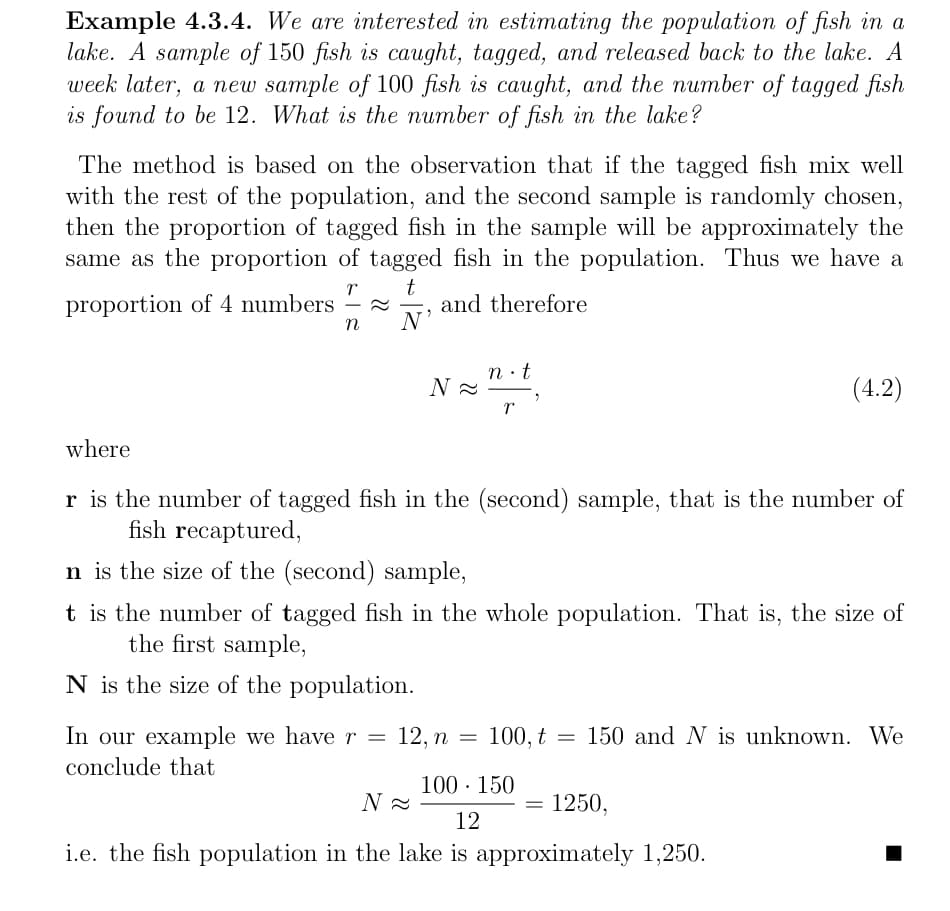Estimate the fish population of Example 4.3.4, page 144, with a 68% confidence level.
Holt Mcdougal Larson Pre-algebra: Student Edition 2012
1st Edition
ISBN:9780547587776
Author:HOLT MCDOUGAL
Publisher:HOLT MCDOUGAL
Chapter11: Data Analysis And Probability
Section: Chapter Questions
Problem 8CR
Related questions
Question

Transcribed Image Text:41. Estimate the fish population of Example 4.3.4, page 144, with a 68%
confidence level.

Transcribed Image Text:Example 4.3.4. We are interested in estimating the population of fish in a
lake. A sample of 150 fish is caught, tagged, and released back to the lake. A
week later, a new sample of 100 fish is caught, and the number of tagged fish
is found to be 12. What is the number of fish in the lake?
The method is based on the observation that if the tagged fish mix well
with the rest of the population, and the second sample is randomly chosen,
then the proportion of tagged fish in the sample will be approximately the
same as the proportion of tagged fish in the population. Thus we have a
t
and therefore
N'
proportion of 4 numbers
n
n·t
(4.2)
where
r is the number of tagged fish in the (second) sample, that is the number of
fish recaptured,
n is the size of the (second) sample,
t is the number of tagged fish in the whole population. That is, the size of
the first sample,
N is the size of the population.
In our example we have r =
12, п 3
100, t = 150 and N is unknown. We
conclude that
100 · 150
N
1250,
12
i.e. the fish population in the lake is approximately 1,250.
Expert Solution
This question has been solved!
Explore an expertly crafted, step-by-step solution for a thorough understanding of key concepts.
This is a popular solution!
Trending now
This is a popular solution!
Step by step
Solved in 2 steps

Knowledge Booster
Learn more about
Need a deep-dive on the concept behind this application? Look no further. Learn more about this topic, statistics and related others by exploring similar questions and additional content below.Recommended textbooks for you

Holt Mcdougal Larson Pre-algebra: Student Edition…
Algebra
ISBN:
9780547587776
Author:
HOLT MCDOUGAL
Publisher:
HOLT MCDOUGAL

Glencoe Algebra 1, Student Edition, 9780079039897…
Algebra
ISBN:
9780079039897
Author:
Carter
Publisher:
McGraw Hill

Holt Mcdougal Larson Pre-algebra: Student Edition…
Algebra
ISBN:
9780547587776
Author:
HOLT MCDOUGAL
Publisher:
HOLT MCDOUGAL

Glencoe Algebra 1, Student Edition, 9780079039897…
Algebra
ISBN:
9780079039897
Author:
Carter
Publisher:
McGraw Hill